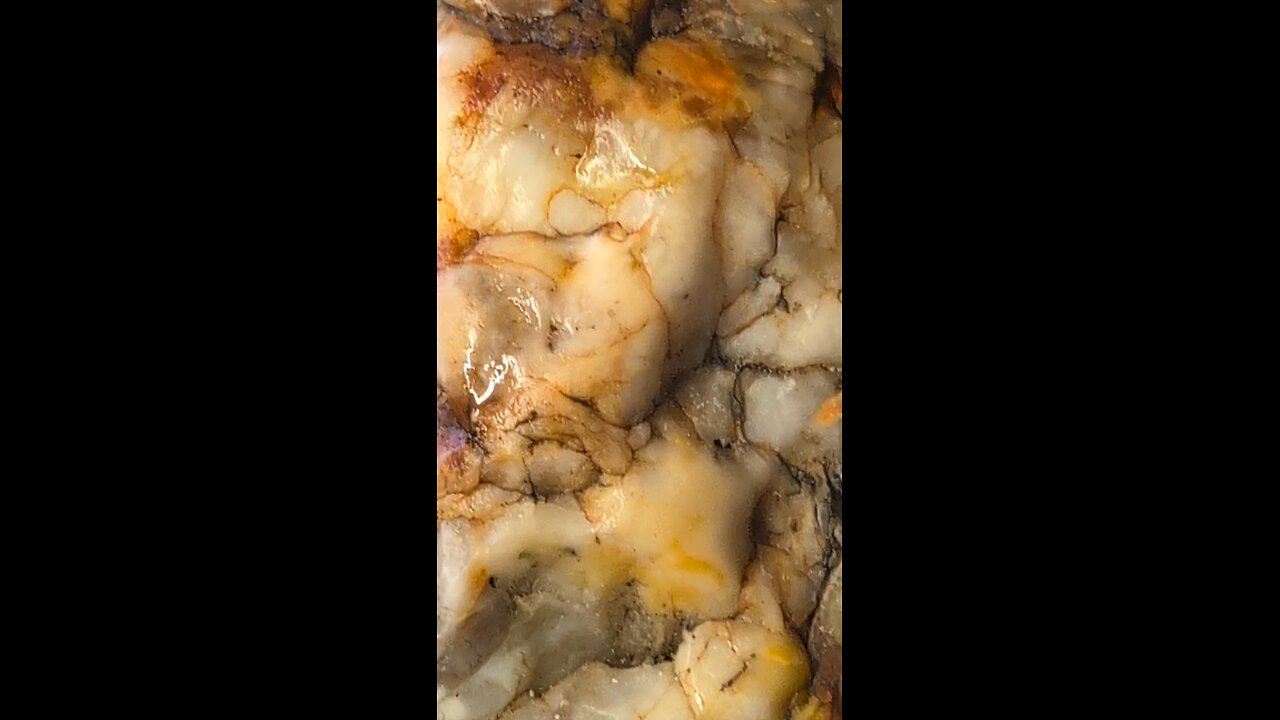Premium Only Content

Agate chunk!
Agate is a microcrystalline variety of quartz, specifically a form of chalcedony, known for its fine grain and bright color patterns. Here are some key points about agate:
Formation: Agate forms in volcanic and sedimentary rocks. It often begins as a cavity in the rock, which then gets filled with layers of silica-rich water. Over time, this solution deposits minerals in layers, creating the characteristic banding of agate. This process can take millions of years.
Appearance: Agate is famous for its beautiful, often banded patterns of color, which can range from translucent to opaque. Colors include white, blue, red, black, yellow, and brown among others, with the patterns formed by the successive layers of chalcedony being deposited. Sometimes, agates can be found with inclusions like moss (moss agate) or even fossils.
Types of Agate:
Banded Agate: Shows clear, concentric bands of color.
Moss Agate: Contains mineral inclusions that look like moss or foliage.
Dendritic Agate: Similar to moss agate but with tree-like or branch-like patterns.
Fire Agate: Contains iridescent layers that appear to glow with fiery colors.
Lace Agate: Features lace-like patterns, most notably in Blue Lace Agate from Namibia.
Crazy Lace Agate: Known for its wild, chaotic patterns of colors.
Locations: Agates are found worldwide, but some of the most famous locations include Brazil, Uruguay, Mexico, Germany, Madagascar, and the United States (particularly in Oregon, Washington, and Idaho).
Uses:
Jewelry: Due to its beauty when polished, agate is widely used in jewelry like rings, pendants, and beads.
Decorative Items: Larger pieces or slices are used for decorative objects, bookends, or as display pieces.
Metaphysical: In metaphysical practices, agate is believed to have various healing properties, like balancing physical, emotional, and intellectual energy, and promoting strength and courage.
Cultural Significance: Agate has been used since ancient times; it was prized in Ancient Egypt for amulets and seals, in Greece and Rome for intaglios and cameos, and by many other cultures for its beauty and supposed protective qualities.
Cutting and Polishing: When cutting agate for jewelry or display, lapidaries look for the most visually appealing patterns. The process involves sawing, grinding, and polishing to bring out the internal beauty of the stone.
Agate's diversity in color and pattern, combined with its durability, makes it one of the most sought-after stones in the world of gemology and mineral collecting.
-
 LIVE
LIVE
Side Scrollers Podcast
2 hours agoMario Galaxy Movie Trailer REACTION + Black Lesbian GOES OFF on Weiner + More | Side Scrollers
879 watching -
 15:49
15:49
Rethinking the Dollar
2 hours agoThis Crypto ‘Freeze Code’ Warning Changes Everything
5K4 -
 1:10:03
1:10:03
The Rubin Report
3 hours ago‘The View’s Sunny Hostin Tries to Shame John Fetterman Until He Puts Her in Her Place
109K56 -
 LIVE
LIVE
LFA TV
17 hours agoLIVE & BREAKING NEWS! | WEDNESDAY 11/12/25
2,694 watching -
 18:53
18:53
Professor Nez
2 hours agoDemocrats TURN on Chuck Schumer & BOOT HIM OUT of the Party!
20.9K6 -
 1:36:52
1:36:52
The Mel K Show
3 hours agoMORNINGS WITH MEL K - Dueling Narratives & Endless Distraction: Don’t Lose Focus! - 11-12-25
23.3K5 -
 LIVE
LIVE
The Shannon Joy Show
2 hours agoH1-B-Trayal! How Many Times Does Trump Have To Punch MAGA In The Face Before They Realize He’s Just Not That Into Them?
190 watching -
 1:56:53
1:56:53
Badlands Media
12 hours agoBadlands Daily: November 12, 2025 – Epstein Emails, COVID Lies & Constitutional Chaos
101K11 -
 43:54
43:54
VINCE
4 hours agoThomas Speciale: The Man Behind John Brennan's Meltdown | Episode 167 - 11/12/25 VINCE
91.3K123 -
 2:42:30
2:42:30
Nikko Ortiz
3 hours agoMILITARY FAILS AND KAREN ACTIVITIES... |Rumble Live
30.8K3